语法 状语从句讲解
- 格式:doc
- 大小:48.50 KB
- 文档页数:5
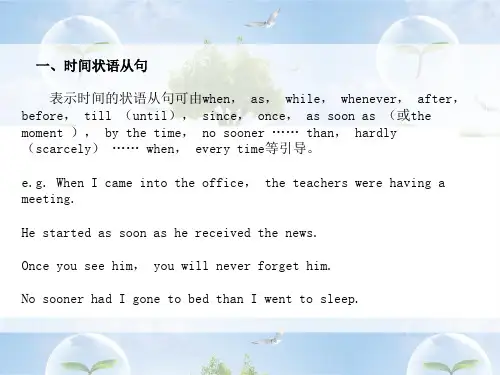
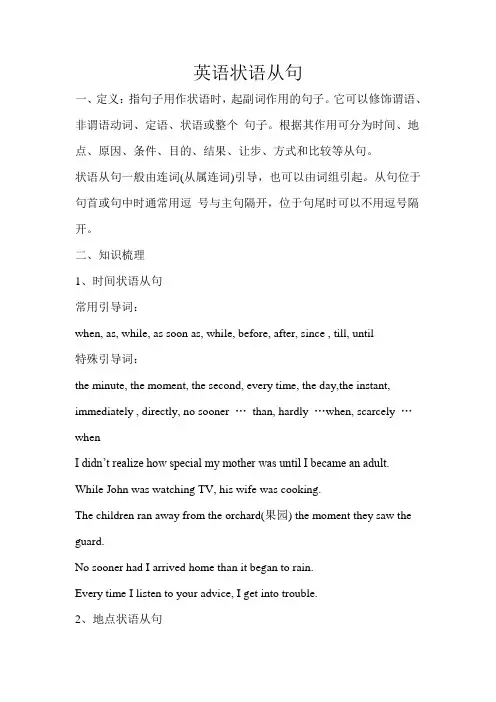
英语状语从句一、定义:指句子用作状语时,起副词作用的句子。
它可以修饰谓语、非谓语动词、定语、状语或整个句子。
根据其作用可分为时间、地点、原因、条件、目的、结果、让步、方式和比较等从句。
状语从句一般由连词(从属连词)引导,也可以由词组引起。
从句位于句首或句中时通常用逗号与主句隔开,位于句尾时可以不用逗号隔开。
二、知识梳理1、时间状语从句常用引导词:when, as, while, as soon as, while, before, after, since , till, until特殊引导词:the minute, the moment, the second, every time, the day,the instant, immediately , directly, no sooner …than, hardly …when, scarcely …whenI didn’t realize how special my mother was until I became an adult. While John was watching TV, his wife was cooking.The children ran away from the orchard(果园) the moment they saw the guard.No sooner had I arrived home than it began to rain.Every time I listen to your advice, I get into trouble.2、地点状语从句常用引导词:where特殊引导词:wherever, anywhere, everywhereGenerally, air will be heavily polluted where there are factories. Wherever you go, you should work hard.3、原因状语从句常用引导词:because, since, as, for特殊引导词:seeing that, now that, in that, considering that, given that, considering that, as much as, so much asMy friends dislike me because I’m handsome and successful.Now that everybody has come, let’s begin our conference.The higher income tax is harmful in that it may discourage people from trying to earn more.Considering that he is no more than 12 years old, his height of 1.80 m is quite remarkable.4、目的状语从句常用引导词:so that, in order that特殊引导词:lest, in case, for fear that,in the hope that, for the purpose that, to the end thatThe boss asked the secretary to hurry up with the letters so that he could sign them.The teacher raised his voice on purpose that the students in the back could hear more clearly.5、结果状语从句常用引导词:so that, so…that, such …that,特殊引导词:such that, to the degree that, to the extent that, to such a degree that,He got up so early that he caught the first bus.It’s such a good chance that we must not miss it.To such an degree was he excited that he couldn’t sleep last night.6、条件状语从句常用引导词:if, unless,特殊引导词:as/so long as, only if, providing/provided that, suppose that, in case that, on condition thatWe’ll start our project if the president agrees.You will certainly succeed so long as you keep on trying.Provided that there is no opposition, we shall hold the meeting here.7、让步状语从句常用引导词:though, although, even if, even though特殊引导词:as(用在让步状语从句中必须要倒装),while ( 一般用在句首),no matter …, in spite of the fact that, while, whatever, whoever, wherever, whenever, however, whicheverMuch as I respect hi m, I can’t agree to his proposal.尽管我很尊敬他, 我却不同意他的建议。
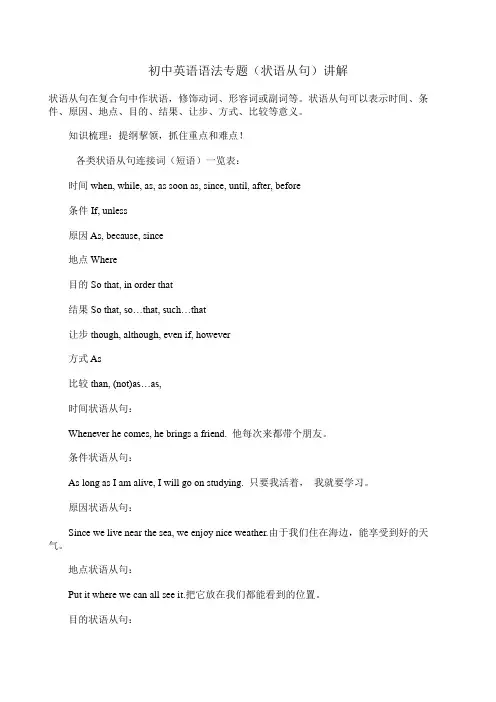
初中英语语法专题(状语从句)讲解状语从句在复合句中作状语,修饰动词、形容词或副词等。
状语从句可以表示时间、条件、原因、地点、目的、结果、让步、方式、比较等意义。
知识梳理:提纲挈领,抓住重点和难点!各类状语从句连接词(短语)一览表:时间 when, while, as, as soon as, since, until, after, before条件 If, unless原因 As, because, since地点 Where目的 So that, in order that结果So that, so…that, such…that让步 though, although, even if, however方式 As比较 t han, (not)as…as,时间状语从句:Whenever he comes, he brings a friend. 他每次来都带个朋友。
条件状语从句:As long as I am alive, I will go on studying. 只要我活着,我就要学习。
原因状语从句:Since we live near the sea, we enjoy nice weather.由于我们住在海边,能享受到好的天气。
地点状语从句:Put it where we can all see it.把它放在我们都能看到的位置。
目的状语从句:Finish this so that you can start another.把这个做完,你可以开始另一个。
结果状语从句:He was so angry that he couldn't say a word. 他气得说不出话了。
让步状语从句:Though he is in poor health, he works hard.虽然他身体不好,但是他工作很努力。
方式状语从句:Students do as the teachers say.学生们按照老师说的去做。
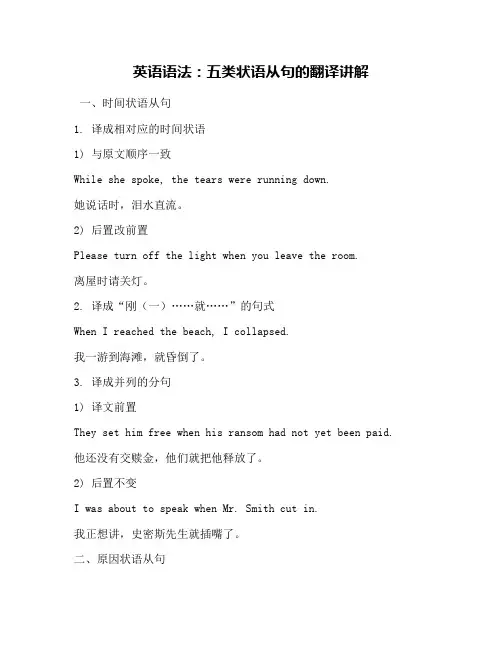
英语语法:五类状语从句的翻译讲解一、时间状语从句1. 译成相对应的时间状语1) 与原文顺序一致While she spoke, the tears were running down.她说话时,泪水直流。
2) 后置改前置Please turn off the light when you leave the room.离屋时请关灯。
2. 译成“刚(一)……就……”的句式When I reached the beach, I collapsed.我一游到海滩,就昏倒了。
3. 译成并列的分句1) 译文前置They set him free when his ransom had not yet been paid.他还没有交赎金,他们就把他释放了。
2) 后置不变I was about to speak when Mr. Smith cut in.我正想讲,史密斯先生就插嘴了。
二、原因状语从句1. 译成表“因”的分句1) “因”在“果”之前The crops failed because the season was dry.因为气候干旱,作物歉收。
2) “果”在“因”之前She could get away with anything, because she looked such a baby.她能渡过任何风险,因为她看上去简直还像娃娃模样。
2. 译成因果偏正复句中的主句Pure iron is not used in industry because it is too soft.纯铁太软,所以不用在工业上。
Because he was convinced of the accuracy of this fact, he stuck to his opinion.他深信这件事准确可靠,所以坚持己见。
3. 译成无关联词的因果关系并列分句Where there is sound, there must be sound waves.哪里有声音,哪里就必有声波。
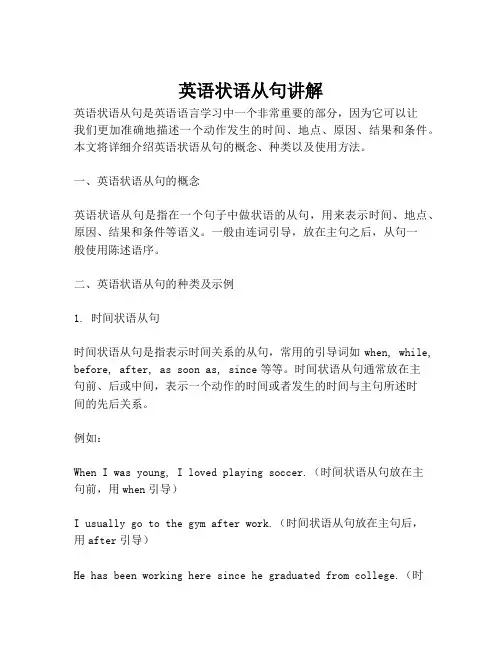
英语状语从句讲解英语状语从句是英语语言学习中一个非常重要的部分,因为它可以让我们更加准确地描述一个动作发生的时间、地点、原因、结果和条件。
本文将详细介绍英语状语从句的概念、种类以及使用方法。
一、英语状语从句的概念英语状语从句是指在一个句子中做状语的从句,用来表示时间、地点、原因、结果和条件等语义。
一般由连词引导,放在主句之后,从句一般使用陈述语序。
二、英语状语从句的种类及示例1. 时间状语从句时间状语从句是指表示时间关系的从句,常用的引导词如when, while, before, after, as soon as, since等等。
时间状语从句通常放在主句前、后或中间,表示一个动作的时间或者发生的时间与主句所述时间的先后关系。
例如:When I was young, I loved playing soccer.(时间状语从句放在主句前,用when引导)I usually go to the gym after work.(时间状语从句放在主句后,用after引导)He has been working here since he graduated from college.(时间状语从句放在主句后,用since引导)2. 地点状语从句地点状语从句表示一个动作所发生的地点,通常由where、wherever 引导。
例如:Wherever you go, I will follow you. (地点状语从句中,wherever 引导)I will go wherever the wind takes me.(地点状语从句中,where 引导)3. 原因状语从句原因状语从句表示主句的动作发生的原因,通常由because、since、as等引导。
例如:Since it was raining outside, I chose to stay at home.(原因状语从句中,since 引导)Because she was sick, she couldn't go to the party.(原因状语从句中,because 引导)4. 结果状语从句结果状语从句用于表示主句所述的情况或动作的结果,通常由so、such...that等引导。
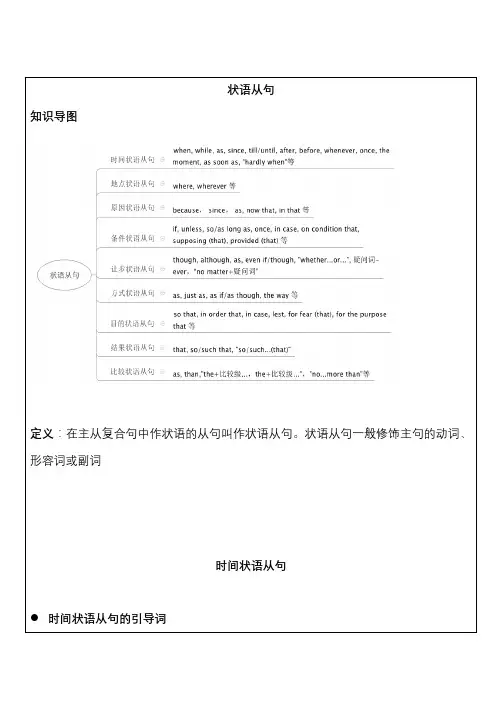

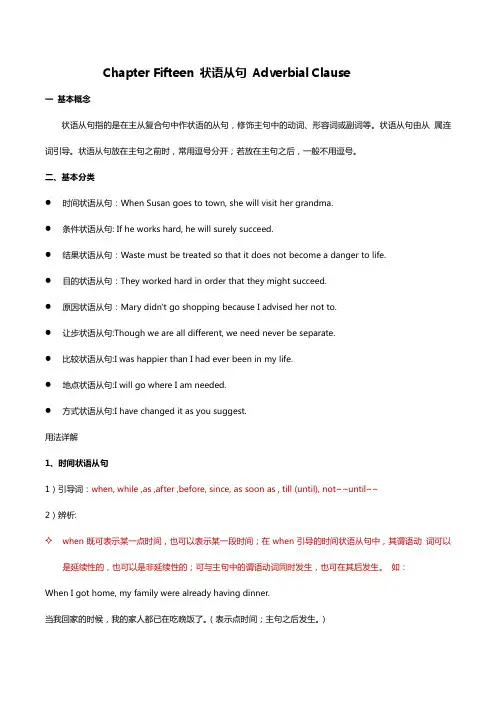
Chapter Fifteen 状语从句Adverbial Clause一基本概念状语从句指的是在主从复合句中作状语的从句,修饰主句中的动词、形容词或副词等。
状语从句由从属连词引导。
状语从句放在主句之前时,常用逗号分开;若放在主句之后,一般不用逗号。
二、基本分类●时间状语从句:When Susan goes to town, she will visit her grandma.●条件状语从句: If he works hard, he will surely succeed.●结果状语从句:Waste must be treated so that it does not become a danger to life.●目的状语从句:They worked hard in order that they might succeed.●原因状语从句:Mary didn't go shopping because I advised her not to.●让步状语从句:Though we are all different, we need never be separate.●比较状语从句:I was happier than I had ever been in my life.●地点状语从句:I will go where I am needed.●方式状语从句:I have changed it as you suggest.用法详解1、时间状语从句1)引导词:when, while ,as ,after ,before, since, as soon as , till (until), not~~until~~2)辨析:✧when既可表示某一点时间,也可以表示某一段时间;在when引导的时间状语从句中,其谓语动词可以是延续性的,也可以是非延续性的;可与主句中的谓语动词同时发生,也可在其后发生。
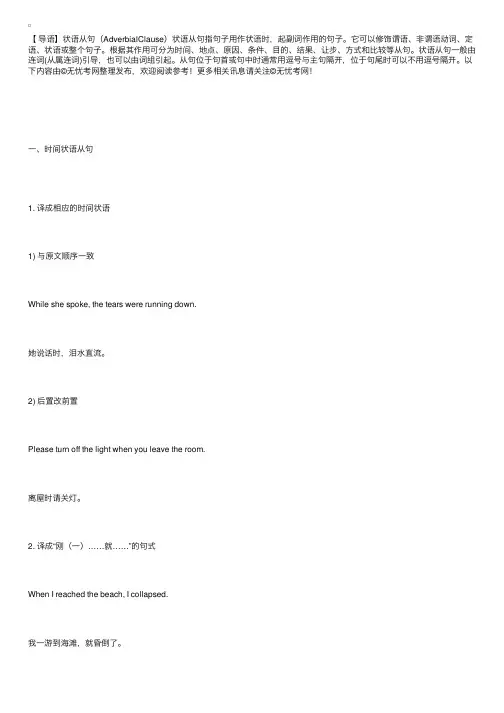
【导语】状语从句(AdverbialClause)状语从句指句⼦⽤作状语时,起副词作⽤的句⼦。
它可以修饰谓语、⾮谓语动词、定语、状语或整个句⼦。
根据其作⽤可分为时间、地点、原因、条件、⽬的、结果、让步、⽅式和⽐较等从句。
状语从句⼀般由连词(从属连词)引导,也可以由词组引起。
从句位于句⾸或句中时通常⽤逗号与主句隔开,位于句尾时可以不⽤逗号隔开。
以下内容由©⽆忧考⽹整理发布,欢迎阅读参考!更多相关讯息请关注©⽆忧考⽹!⼀、时间状语从句1. 译成相应的时间状语1) 与原⽂顺序⼀致While she spoke, the tears were running down.她说话时,泪⽔直流。
2) 后置改前置Please turn off the light when you leave the room.离屋时请关灯。
2. 译成“刚(⼀)……就……”的句式When I reached the beach, I collapsed.我⼀游到海滩,就昏倒了。
3. 译成并列的分句1) 译⽂前置They set him free when his ransom had not yet been paid.他还没有交赎⾦,他们就把他释放了。
2) 后置不变I was about to speak when Mr. Smith cut in.我正想讲,史密斯先⽣就插嘴了。
⼆、原因状语从句1. 译成表“因”的分句1) “因”在“果”之前The crops failed because the season was dry.因为⽓候⼲旱,作物歉收。
2) “果”在“因”之前She could get away with anything, because she looked such a baby.她能渡过任何风险,因为她看上去简直还像娃娃模样。
2. 译成因果偏正复句中的主句Pure iron is not used in industry because it is too soft.纯铁太软,所以不⽤在⼯业上。
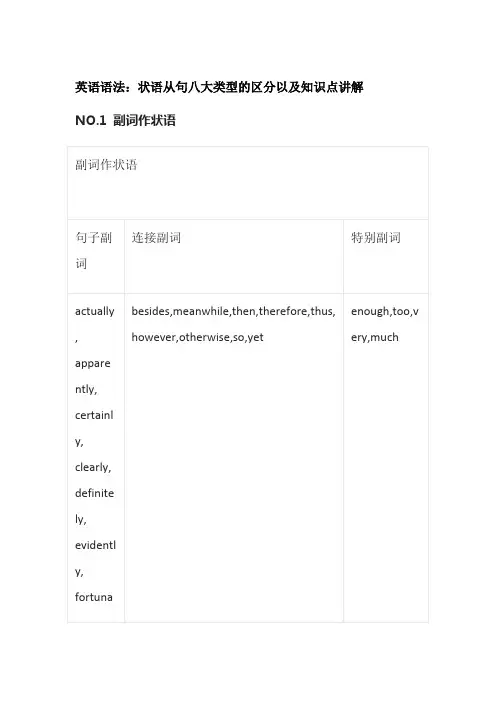
英语语法:状语从句八大类型的区分以及知识点讲解NO.1 副词作状语(1)句子副词:句子副词用于修饰句子(而不是修饰某个单个的词),反映说话人的观点和看法。
如actually, apparently, certainly, clearly,definitely, evidently, fortunately, frankly, honestly, luckily, obviously, perhaps, possibly, probably, surely, undoubtedly, unexpectedly 等。
作用以及位置:句子副词通常位于句首(或分句句首)。
Eg:Obviously he can't tell the difference between them. 显然他无法区别两者的不同。
I arrived late but luckily the meeting had been delayed. 我迟到了,幸而会议推迟了。
但有些句子副词也可以出现句中。
eg:He smiled nastily. He evidently knew something I didn't. 他发出狞笑,他显然知道一些我所不知道的事。
有的句子也可用作其他种类的副词,不过这往往会导致位置和语义的变化:Clearly he didn't say so. 显然他没有这样说。
(句子副词)He didn't say so clearly. 他说得没有那么清楚。
(方式副词)(2)起连词作用的副词连接副词就是连接词,如besides,meanwhile,then, therefore, thus, However,Otherwise, so, yet 等。
作用以及位置:常放在两个句子中间,前面为逗号,后面放连接词,从句之前。
注意:so 也可放在形容词之前做修饰,yet 可放句尾或从句之前。
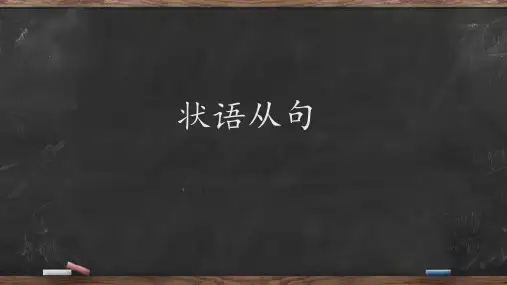
高中英语语法系统讲解之十一状语从句状语从句在句中作状语,修饰主句中的动词、形容词或副词等,有时修饰整个主句。
状语从句放在主句之前时,常用逗号分开;放在主句之后,一般不用逗号。
状语从句按其意义和作用分为时间、条件、原因、让步、目的、结果、方式、比较、地点等9种。
1. 时间状语从句时间状语从句可放在句首、句中或句尾。
常用when,while,as,after,before,since,until,once,as soon as,the minute / moment“一……就……”,hardly … when,no sooner … than“刚……就……”等连接词引导。
○1连词when,while,as都表示“当……的时候”,但是when引导的从句的动作和主句的动作可以同时发生,也可以先后发生;用as,while时则强调主句和从句的动作同时发生。
如While I was reading, he came in.As he walked along the street, he sang happily.但当从句表示“随时间推移”时,只能用连词as,不能用when或while。
如As time goes on, I like to speak English more and more.○2从属连词as soon as,immediately,directly,the moment,the minute,no sooner … than …, hardly / scarcely … when …,once引导的从句都表示从句的动作一发生,主句的动作随即就发生,意为“一……就……”,从句中用一般时态代替将来时态。
如Once you remember it, you’ll never forget it.The moment I heard the voice, I knew father was coming.No sooner had we arrived at the station than the train left.温馨提示:as soon as,the moment引导的从句表示“一……就……”;no sooner … than …,hardly … when引导的从句表示“刚……就……”。
一,状语从句状语从句在主从复合句中修饰主句中的动词、形容词或副词等,起副词的作用。
状语从句由从属连词引导,从属连词在从句中不担任任何句子成分。
状语从句可位于主句之前,也可位于主句之后。
位于主句之前,一般要加逗号与主句分开;位于句末则不需要。
状语从句根据它所表达的意思可分为时间、地点、原因、目的、结果、比较,让步、方式和条件状语从句等类。
(一),时间状语从句引导时间状语从句的从属连词有:when, while, as soon as, before, after, since , till, until 等【注】1,until (till) 直到,在用until 表达时间状语的句子中,主句中的动词是要十分小心去选择。
如动词是持续性动词,它要用肯定句,如:I studied hard until 12 o'clock last night. 如果动词是瞬间截止性动词,则要用否定句,即,not---until “直到…才”。
如:He didn't go to bed until his mother came back.They didn’t stop until they finished t he work .2,时间状语从句中的谓语动词不能用,将来时,终能用一般现在时表示一般将来时,即“主将从现”原则。
如,When he comes, I’ll tell him about it.I will call you as soon as I arrive in Beijing. 我到北京就将给你打电话(二),条件状语从句通常由从属连词if,unless等引导【注】1,条件状语从句与时间状语从句一样,从句中不能用将来时态,要用一般现在时态表示一般将来时态,也符合“主将从现”原则。
如,If it snows tomorrow, we will build a snowman.If it rains, they won't go to the park on SundayI won’t go to his party unless I am invited .,2,要区别是条件、时间状语从句还是宾语从句,因为在宾语从句中该用什么时态用什么时态,如:I want to know if he will come here tomorrowI want to know if it will rain tomorrow. If it doesn’t rain, I will go hiking.I don’t know when he will come, When he comes, I’ll tell him about it.(三),让步状语从句通常由从属连词though(although)(虽然,尽管),even if(even though)(即使)等引导注:翻译是后半句带有转折的意味,但不能由but连接。
语法状语从句由从句担任的状语,在句子中可修饰谓语(或其它动词)、形容词、副词或就是整个句子,它可以用来表示时间、地点、原因、目的、结果、条件、方式、比较、让步等。
第一讲时间, 地点状语从句时间状语从句:when, while, as, before, after, since , wheneveruntil, till, by the time(注意时态)as soon as, had hardly…when, had no sooner…than,(on doing sth…)the moment, every time/ each time, the first time, oncee、g: When he came, I had cleaned the classroom、He didn’t stop working until his mother came bake、He worked until his mother came back、As soon as he returned, he bought a new flat、He had no sooner returned than he bought a new flatHe came to scene the moment he heard the news、I thought her nice and honest the first time I met him、Once he makes up your mind, he won’t change his mind、It was two years before I met him again、= Two years passed before I met him again、注意点1、when引导的从句动词可以就是延续性的或短暂性的,while引导的从句中动词必须就是延续性的; while有时并不表示时间,而表示对比,表示“而”、“却”。
When I got home I found the door locked、While(或When)we were working in the fields, it suddenly began to rain、His pencil is red, while mine is yellow、2、till与until not…until/till 解释为直到…才…主句动词一般就是短暂性的…till/until… 解释为直到…为止主句动词一般就是延续性的一般情况下可以互换,但until可以位于句首,till则不能。
He worked until it was dark、He didn’t stop working until it was dark、Until it stops raining,the children can’t go out、=Not until the rain stops can the children go out、地点状语从句引导地点状语从句的连词就是where 与wherever等。
I ll go wherever the people want me to go、(wherever=to any place where)He works where his grandfather fought、(where=in the place where)You must stay where you are、= You must stay in the place where you are、Wherever you go, I go too、Where there is water, there is life、(那儿有… 那儿就有… Where there is a will, there is a way、) 圈出其中的从句并翻译:1.Whenever it is his turn to speak, he gets nervous、2.Every time he comes, he always tells us something interesting、3.When I get the news, I will let you know as soon as possible、4.Once he makes a promise, he will never break it、5.I had no sooner run into the school gate than I heard the bell for class、6.I found the lost watch under a desk after the children had left for home、7.He had to be called two or three times before he came down to dinner、8.We didn’t notice anything wrong with the washer until we started using it、9.The hunter made mark on the tree where he stops、10.Wherever he is, he will find time to do some reading、第二讲原因、目的、结果状语从句原因状语从句原因状语从句就是表示原因或理由的,引导这类从句的最常用的连词就是because, since, as , now that(既然)等,for 表示因果关系时(它引导的不就是从句)为并列连词,语气不如because强, considering that, seeing that(既然,由于) not that…but that…(不就是因为…而就是因为…)e、g、He is disappointed because he didn't get the position、Since everybody is here, let’s begin、It must have rained last night, for the ground is still wet、Seeing that the weather is bad, we’ll stay at home、注意点: 1、回答以why提出的问题时,只能用because,而不能用as等。
2、since=now(that),表“既然”意,表示已知的或明显的原因,由此加以推论。
Now that/Since you are free today, you may have a rest at home or go out for a walk、3、for 就是一个并列连词,用来连接两个并列句,引导的句子就是对前面一句话的内容的推测或补充说明。
(一般有逗号逗开)The day has broken, for the birds are singing、4、区别几个介词短语:because of , due to, owing to, on account of目的状语从句引导词有so that, in order that, that, in case(免得,以防), for fear that。
目的状语从句谓语常含有can/could/may/might/will/would等情态动词。
e、g: He said aloud so that everybody could hear him、I left the room quietly for fear that I might wake him up、Speak clearly, so that they may understand you、He left early in case he should miss the train、结果状语从句结果状语从句就是表示事态结果的从句,通常主句就是原因,从句就是结果。
由so that (从句谓语一般没有情态动词), so … that, such … that等引导。
1.He works so hard that he makes great progress in his studies、2.It s such a difficult problem that nobody can work it out、3.There s not any noise here so that I feel very comfortable、c、f、I got up early, so that I caught the bus、I got up early so that I could catch the bus、圈出其中的从句并翻译1.He had to do a part-time job after work because he needed money for his marriage、2.Since you know you are wrong, you’d better admit it、3.I didn’t go to see him, for a heavy snow was falling、4.Seeing that the weather is bad, we will stay at home、5.He always takes a seat in the first row so that he can hear better、6.In order that they can have more time for study, they often eat fast food、7.She had such a good experience that I would always remember it、8.I stayed up late last night, so that I felt sleepy in class today、9.I wrote as clearly as possible so that I might get high marks、10.I wrote as clearly as possible, so that I got high marks、第三讲条件、方式、比较、让步状语从句条件状语从句条件状语从句分真实性(有可能实现的事情)与非真实性(条件与事实相反或者在说话者瞧来不大可能实现的事情)条件句。